 Pseudomyrmex pallidus a beautiful golden twig ant |  Pseudomyrmex gracilis a twig ant from Mexico | 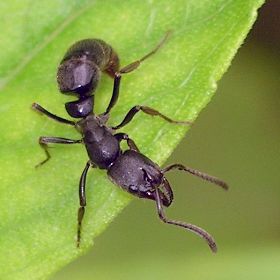 Pachycondyla harpax a panther ant on the prowl |
After rambling through interests such as seashells, fossils, trains, microbes, turtles, seedpods, bones, taxonomy, mushrooms, comparative anatomy, art and music, I have eventually ended up back at insects. While this diverse class of animals contains many remarkable groups, one family that is particularly fascinating is Formicidae, the ants. In our modern U.S. society, which does not particularly value biology as popular entertainment, it is quite noteworthy that two of the leading spokesmen in the field, personalities that many in the general public recognize at least by name (E.O. Wilson and Mark W. Moffett) and have probably seen on television, happen to be myrmecologists. That means, for the uninitiated, "folks who study ants."
I'll admit that ants didn't grab me immediately when I gravitated back to the study of entomology after retiring from teaching. Well, ants DID grab, as well as sting, me, but I mostly just squished them; like everyone else here in the South, I hold no fondness for Imported Fire Ants. During the past ten years, though, I've run across some seriously cool ants. I even wrote a brief account of one ant adventure a couple of years ago.
But there are other stories to tell. Most of them have been previously documented, but they are new to me, and each time I witness a surprising behavior, identify a species I've not before seen, or learn about their wonderful adaptations, my respect for ants grows.
One of my early lessons about ants here in Austin was from our first pest control professional. We had signed a termite management contract with a local company and the cheery, talkative representative came by to inspect our house. He was quite willing to share his knowledge and the one fact that I still remember was that he told me that people often use the wrong name for the tiny black ants that show up on kitchen counters. They are not Sugar Ants, as many people assume. That name, as he correctly pointed out, refers to several other kinds of ants, none of which are solid black. The official name for that tiny black species is Little Black Ant. Creative.
 Pseudomyrmex pallidus a beautiful golden twig ant |  Pseudomyrmex gracilis a twig ant from Mexico |  Pachycondyla harpax a panther ant on the prowl |
I sometimes find ants that I don't recognize as the usual carpenter, acrobat or fire ants. These relatively solitary ants forage by themselves instead of in a large group, but they still belong to a colony that lives in a nest. After doing a little research, I've been able to pin names on these curious creatures. One is the Twig Ant. This slender ant lives in colonies that reside within the smaller branches on trees. A native Twig Ant around here is a beautiful gold color, while a larger cousin, an import from Mexico, is two-toned black and brown. The big one has a potent sting. Another large ant I see very rarely is the Panther Ant. This stream-lined insect has a pointed abdomen that, unlike many ants with short, rounded abdomens, is capable of flexing. Emphasizing the relationship to wasps, the pointed abdominal tip is also a reddish brown color, making it look like it can sting, although I've never tested this one. One other distinctive uncommon ant took me a long time to identify. This ant has long, graceful legs and rather long yet slender mandibles. I couldn't find any reference to it at all, but then I didn't have much beyond a description to help. Then one day I saw this species carrying a pillbug. The ant was working hard to haul the sizable crustacean up a stone wall. I had never seen an ant bother with something as well-armored as a pillbug before, but when I looked up "ants that eat pillbugs," the answer was revealed. Leptogenys elongata really does specialize in hunting terrestrial crustaceans, hence the long jaws and legs to accommodate their prey.
The winged forms of ants are called alates: the females that will become queens and the males that will mate with them. These are usually easy to see and I frequently photograph them. One small, rather nondescript alate surprised me when I saw its face, which was too small for me to see very well before enlarging my photo on the computer screen. The front part of its head looked like it had been chopped off! There is an elegantly practical reason for this odd feature. These ants live in small colonies housed within tree branches. The opening to their nest is a circular hole. All it takes to completely block the entrance to the nest is one worker within placing her flat and very well-armored face into the hole opening, thereby keeping potential threats at bay.
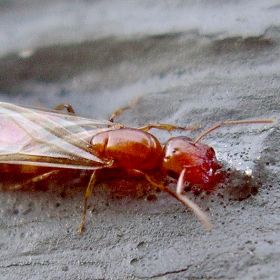 Camponotus etiolatus a small carpenter ant with a flat face | 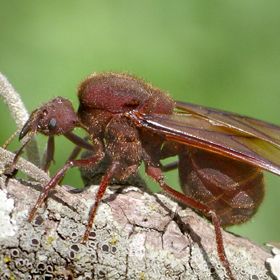 Atta texana the massive female Texas leafcutter ant alate | 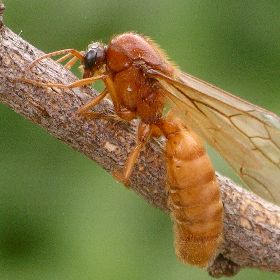 Neivamyrmex sp. a "sausage fly" |
A far more impressive alate that I find around here bears the popular name of Sausage Fly. This is the male of a Legionary Ant, a kind of army ant. Army ants in North America are not quite as spectacular as those in Africa, but they do raid other ant nests and aggressively attack their miniscule prey. I've never seen a female Legionary Ant alate, but the males are surprisingly large. Their abdomens are long and fat, hence the comparison to breakfast links.
The biggest female alates I've seen are those of the Texas Leafcutter Ant. While the numerous workers are a pretty normal ant size, the future queens are humongous. Not only are they big, but they look like they are covered in medieval armor!
One of the interesting things that I've learned about ant colony size is that it directly affects the behavior of the individual ants. Members in very big colonies move quickly and tend to attack predators, as the ants are constantly stimulated by the presence of thousands of their sisters. This is obvious when encountering a nest of Imported Fire Ants, Red Harvester Ants (which have the most painful sting I've experienced), or the Texas Leafcutters. The enormous colonies of Texas Leafcutters are just one extreme, though, of the fungus-feeding ants. Another kind of ant that maintains fungus gardens looks and behaves much differently. This one lives in small colonies and the individuals move about more slowly. They are chunkier looking, especially when compared to their sleek, fast-moving cousins. These slow, less urbanized ants even respond differently when attacked. While the Texas Leafcutters will flee or bite, Trachymyrmex turrifex will simply curl up and play dead.
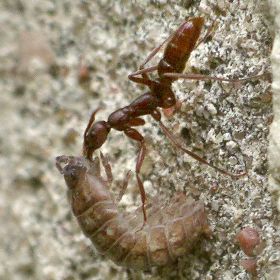 Leptogenys elongata a specialized hunter with its pillbug prey | 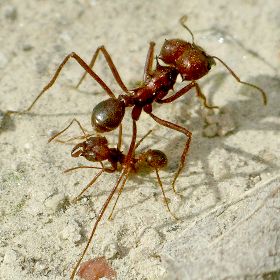 Atta texana Texas leafcutter ant major & minor workers | 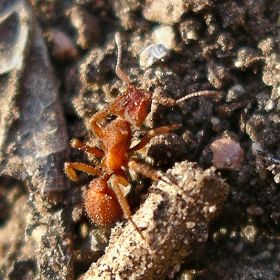 Trachymyrmex turrifex a leafcutter ant that lives in small colonies |
As evidenced by all these different examples, an ant is not just an ant. Their small size notwithstanding, the different kinds of ants all have their own characteristics and fascinating survival strategies. They are interesting enough that it is even worth getting down close to the ground, in spite of the discomfort of bending our tall bodies that far, and spending a little time watching these curiously mesmerizing creatures.